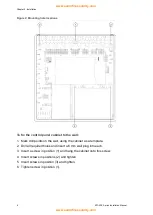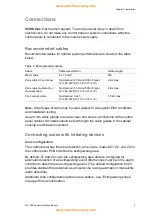
Chapter 2: Installation
ZP1-X3E Series Installation Manual
9
Table 4: Zone termination
Installation type
Termination
EN 54-2
4.7 kΩ, 5%, 1/4 W end-of-line resistor
BS 7273
Active end-of-line device (see note below)
EN 54-13
EOL-Z end of line device (polarity sensitive)
Intrinsically safe
4.7 kΩ, 5%, 1/4 W end-of-line resistor
Note:
For BS 7273 installations an active end-of-line device must be installed
(instead of an end-of-line resistor). Unused zones must be terminated with an
active end-of-line device or configured as passive end-of-line and terminated with
a
4.7 kΩ, 5%, 1/4 W end-of-line resistor.
The type of zone termination can be configured on a zone-by-zone basis. See
“Zone configuration” on page 55. Advanced installer user level access is
required.
Connecting fire detectors
Connect detectors as shown in Figure 3 on page 8.
The panel supports conventional detectors. To guarantee optimal operation, use
the detectors specified in the compatibility list. For more information on fire
detectors, see Chapter 5 “Technical specifications” on page 79.
Note:
For BS 7273 installations a diode must be connected on the detector base
(see your detector installation manual for more details).
Connecting fire alarm manual call points
Connect fire alarm manual call points in parallel. Each fire zone can support a
maximum of 32 manual call points.
In zones used for fire detection, manual call points must have a resistance
installed in series with the normally open (NO) contact for activation. This avoids
reporting a short circuit fault and allows identification of the alarm type (automatic
or manual) based on the impedance.
In zones used for the extinguishing area, alarms are always reported as
automatic (detector), but indications may vary for other panels in a network. A
series impedance is also required to avoid reporting a short circuit fault.
The resistance required depends on the zone type, as shown in the table below.
Resistance must be rated at 1 W minimum.
Table 5: Fire alarm manual call point resistance values
Zone type
EN 54-2, BS 7273
EN 54-13
Intrinsically safe
Mixed detection
100 Ω
Not supported
Not supported
Manual detection
100 to 680 Ω
100 to 470
Ω
250 to 560
Ω
















































